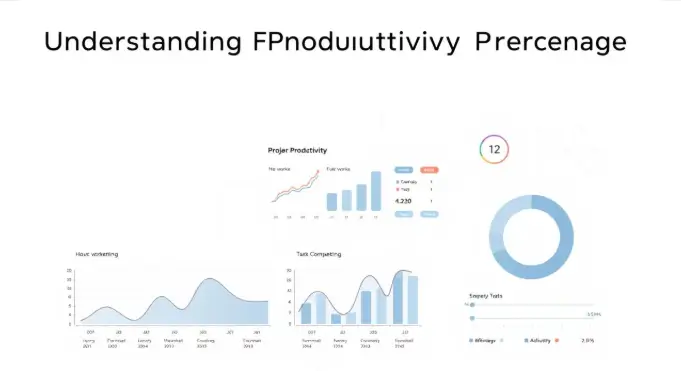How To Calculate Productivity Percentage
Business leaders face a lot of pressure to increase team productivity. Slack’s State of Work 2023 report shows that 71% of business leaders feel pressured to get more out of their teams. This highlights the need to measure productivity accurately.

Knowing productivity percentage is key for businesses looking to improve. It helps check how well processes and employees work. By calculating this, companies can find ways to get better.
Key Takeaways
- Understanding the importance of productivity percentage.
- Learning the formula to calculate productivity.
- Applying the productivity formula in real-world scenarios.
- Improving team productivity through accurate measurement.
- Enhancing business operations by optimizing productivity.
Table of Contents
Understanding Productivity Percentage
Knowing about productivity percentage is key for businesses wanting to do better. It shows how well inputs are turned into outputs. It helps companies check their performance and make smart choices.
Definition of Productivity Percentage
Productivity percentage is the ratio of output to input, shown as a percentage. It shows how well resources like labor, materials, and equipment are used. For example, it looks at how much an employee produces compared to what they use.
Why Measuring Productivity Matters
Measuring productivity is important for many reasons. It helps find where things can be better, use resources better, and do better overall. By watching productivity, companies can set goals, encourage workers, and make choices based on facts.
Different Types of Productivity Metrics
There are many ways to measure productivity. These include:
- Labor productivity
- Machine productivity
- Total factor productivity
1. Labor Productivity
Labor productivity looks at how much is made per unit of labor. It’s key for seeing how well a company’s workers are doing.
To calculate labor productivty check our labor productivy calculator
2. Machine Productivity
Machine productivity checks how well machines and equipment work. It’s important for companies that use a lot of automation.
3. Total Factor Productivity
Total factor productivity looks at how well all inputs are used together. It gives a full picture of a company’s productivity.

By using these productivity metrics, companies can learn a lot about their work. They can then make changes to get better.
The Basic Formula for How to Calculate Productivity Percentage
Measuring productivity starts with a simple formula. It shows how much you get out compared to what you put in. This is key for knowing your productivity percentage, a must for checking how well things are running.
The Standard Productivity Formula
The basic formula is:
Productivity = Output / Input.
It’s the core of measuring productivity. It shows how much you produce compared to what you use.
Input vs. Output Measurements
To use the formula, you need to measure input and output well. Output is what you make or do. Input is what you use, like labor and materials. For example, in making things, output is the number of items made. Input is the hours of work.
Converting to Percentage Format
To show productivity as a percentage, multiply the output/input ratio by 100. This makes it easier to understand and compare, as percentages are straightforward.
Real-World Example Calculation
Imagine a factory making 1000 units in a week with 500 labor hours. The productivity is 1000 units / 500 hours = 2 units per hour. To turn this into a percentage, if the standard is 1.5 units per hour, the percentage is (2 / 1.5) * 100 = 133.33%. This means the factory is 133.33% as productive as the standard.
By using this basic formula, companies can see how productive they are. This helps them make better choices to improve how things work.
Gathering the Necessary Data
To measure productivity, you first need to gather the right data. This includes looking at both what you produce and how much it costs. You also need to pick the right time frame for these measurements.
Identifying Relevant Outputs
Outputs are what you get from your work. Look at both the numbers and the quality of what you produce.
Quantitative Outputs
Quantitative outputs are numbers you can count, like how many items you make or how many sales you have. These are easy to track and give you a clear number.
Qualitative Outputs
Qualitative outputs are about how well you do your job. This includes how happy customers are or how well your work meets its goals. Measuring these can be trickier and might need special tools, like surveys.
Measuring Resource Inputs Accurately
Inputs are what you use to do your work, like people, materials, and tools. Getting these right is key to a good productivity score. Things like how many hours people work, what materials you use, and how much you spend on tools are important to track.
Establishing Time Periods for Measurement
The time you measure productivity for can change the results. You might look at daily, weekly, monthly, or quarterly numbers.
By focusing on the right outputs, measuring inputs well, and choosing the right time, you can get the data needed to figure out your productivity percentage.
Step-by-Step Guide to Productivity Percentage Calculation
Calculating productivity percentage is easy when you break it down. You need to measure output and input, do the math, and understand the results. This systematic approach helps you get accurate numbers.
Measuring Total Output
The first step is to measure total output. Total output is the quantity or value of goods and services produced in a certain time. To measure it well, focus on the following:
- Find the key products or services that bring in revenue or value.
- Use the right metrics, like units produced or tasks done, to quantify output.
- Make sure your output measurement stays the same over time.
Calculating Total Input
After measuring output, calculate total input. Total input includes all resources used to produce output, like labor hours, raw materials, and equipment. To calculate it accurately:
- Collect data on all input resources.
- Measure each input resource in the right units, like hours worked or materials used.
- If needed, convert different inputs into the same unit, like money.
Dividing Output by Input
Now, divide output by input. This gives you a ratio that shows productivity. The formula is: Productivity Ratio = Total Output / Total Input.
Converting to Percentage
To show the ratio as a percentage, multiply by 100. This makes it easier to compare and understand productivity changes. The formula for productivity percentage is: Productivity Percentage = (Total Output / Total Input) * 100.
Practical Calculation Example
Let’s look at an example. A manufacturing unit makes 10,000 units in a month. They use 500 labor hours and $10,000 in materials. If output is 10,000 units and input is 500 labor hours, the ratio is 20 units per hour. To make it clearer, compare it to the total input cost.
By following these steps, you can accurately calculate productivity percentage. This gives you valuable insights into your efficiency.
Industry-Specific Productivity Calculations
Calculating productivity in different industries is key to improving performance. Each field has its own way of working, needing special methods to measure productivity.
Manufacturing Productivity Formulas
In manufacturing, we use formulas to measure how well things are made and how well machines work.
Production Line Efficiency
Production line efficiency shows how much is made compared to what could be made. It helps find and fix problems in making things.
Equipment Effectiveness
Overall Equipment Effectiveness (OEE) looks at how well equipment is used. It’s found by multiplying three things together.
OEE = Availability × Performance × Quality
| Metric | Description | Example |
| Availability | Percentage of time equipment is available | 90% |
| Performance | Speed of production relative to maximum speed | 95% |
| Quality | Percentage of good products produced | 99% |
| OEE | Overall Equipment Effectiveness | 85% |
Service Industry Productivity Metrics
In the service industry, we look at how well services are delivered. This includes how happy customers are, how long it takes to serve them, and how busy employees are.
Knowledge Worker Productivity Measurement
For knowledge workers, we measure productivity by what they produce. This could be reports, projects, or tasks done in a set time.
Sales Team Productivity Calculation
Sales team productivity is about how much they sell. We look at sales revenue, how often they make a sale, and how long it takes to sell something. These help us see how good their sales strategies are and where they can get better.
Personal Productivity Percentage Tracking
Tracking personal productivity is key for better daily tasks and long-term goals. It helps people work more efficiently and reach their goals faster.
Defining Personal Output Metrics
To track personal productivity, you need to know what counts as output. This could be tasks done, projects finished, or goals reached. For example, a writer might track articles written or words typed each day.
Tracking Your Time as Input
Time is crucial in productivity tracking. Using time-tracking tools or apps helps record hours spent on tasks. This info is needed to figure out productivity percentage.
Daily and Weekly Productivity Calculations
Checking productivity daily and weekly helps spot areas for improvement. For instance, if someone works 8 hours a day and does 4 tasks, their productivity can be calculated. It’s based on tasks per hour.
Using Personal Productivity Data for Improvement
The main aim of tracking personal productivity is to find ways to get better. By looking at the data, people can tweak their work flow, set better goals, and boost their efficiency.
As
“You can’t manage what you don’t measure.”
Peter Drucker
, starting to track personal productivity is the first step to doing more in less time.
You can use our productivity calculator to calculate your personal productivity.
Tools and Software for Tracking Productivity
In today’s fast-paced work environment, using the right tools and software is key for tracking productivity. Many solutions exist, from simple time tracking to complex project management.
Productivity Tracking Applications
Productivity tracking apps monitor time spent on tasks and projects. Time tracking tools like Toggl and Harvest let users log hours on specific tasks. This gives insights into productivity patterns.
Time Tracking Tools
Time tracking tools are vital for seeing where time is spent. They help find inefficiencies and improve workflows.
Project Management Software
Project management software like Asana and Trello track progress and help teams work together. These tools are great for managing big projects and boosting team productivity.
Spreadsheet Templates for Calculations
For a manual approach, spreadsheet templates can calculate productivity. Microsoft Excel and Google Sheets have templates for tracking productivity metrics.
Enterprise Resource Planning Systems
Enterprise Resource Planning (ERP) systems combine business functions, including productivity tracking. These systems give deep insights into organizational productivity.
Productivity Dashboards and Analytics
Productivity dashboards and analytics tools show productivity data in a clear way. Tools like Klipfolio and Power BI offer customizable dashboards for specific metrics.
Common Mistakes When Calculating Productivity Percentage
Calculating productivity percentage is tricky. Businesses often make mistakes that lead to wrong measurements and bad decisions.
Overlooking Quality Factors
One big mistake is ignoring quality. Just focusing on how much you do can hurt quality. This can lower your productivity.
Inconsistent Measurement Periods
Using different time frames for measuring can mess up your numbers. It’s key to use the same time for all measurements to compare correctly.
Failing to Account for All Inputs
Not counting all resources is another error. This includes labor, materials, and even overhead costs.
Misinterpreting Productivity Data
Getting data wrong is a big mistake. It’s important to understand the data’s context and limits to make smart choices.
Focusing Only on Individual Metrics
Looking only at one metric can give a partial view. A complete picture is needed for true productivity understanding.
| Common Mistake | Impact on Productivity | Corrective Action |
| Overlooking Quality Factors | Compromised quality, reduced overall productivity | Implement quality control measures |
| Inconsistent Measurement Periods | Inaccurate comparisons, skewed productivity data | Standardize measurement periods |
| Failing to Account for All Inputs | Incomplete data, inaccurate productivity calculations | Track all resources and inputs |
Knowing these mistakes and avoiding them can help businesses get their productivity numbers right. This leads to better decisions and higher productivity.
Interpreting Your Productivity Percentage Results
Understanding your productivity percentage is key to working better and getting more done. After you figure out your productivity percentage, you need to see how it fits into your field and work setup.
What Is Considered a “Good” Productivity Percentage
A “good” productivity percentage changes a lot depending on the industry. For example, factories might have different goals than service companies. A higher percentage usually means you’re working more efficiently.
Comparing Against Industry Benchmarks
To really get a feel for your productivity, compare it to what’s normal in your field. This lets you know if you’re doing better or worse than others.
Tracking Changes Over Time
Watching how your productivity changes over time is very important. It shows you how your work methods or operations are affecting your results.
Identifying Productivity Trends and Patterns
Looking at your productivity data over time can reveal trends and patterns. This information is super helpful for making smart choices about how to improve your work.
Using Productivity Data for Decision-Making
Productivity numbers should guide your decisions. Use them to find areas to get better, manage resources better, and find ways to increase your productivity.
| Productivity Percentage Range | Interpretation |
| Below 50% | Low productivity; significant improvements needed |
| 50-70% | Average productivity; some improvements possible |
| Above 70% | High productivity; efficient operations |
Conclusion
Calculating productivity percentage is key for businesses and individuals wanting to boost their efficiency. It helps them make smart decisions based on data. This way, they can improve their operations.
To measure productivity percentage right, you need to know what outputs are important. You also have to track the resources used and set a consistent time frame. Following these steps helps businesses reach their full potential and see big improvements in productivity.
In the end, calculating productivity percentage is a great way to increase efficiency and grow. By using this method, companies can stay ahead, meet their goals, and succeed. This leads to a fulfilling outcome from all the hard work in calculating productivity percentage.
FAQ
-
What is productivity percentage?
Productivity percentage shows how efficient a process or system is. It’s found by dividing the output by the input and showing it as a percentage.
-
Why is it important to measure productivity percentage?
It’s key for businesses and individuals to know their efficiency. This helps spot areas to improve and make better decisions.
-
What are the different types of productivity metrics?
There are many productivity metrics. These include labor, machine, and total factor productivity. Each looks at different aspects of productivity.
-
How can I track my personal productivity percentage?
To track your productivity, define what you want to achieve. Then, log your time spent. Do this daily and weekly to see how you’re doing.

